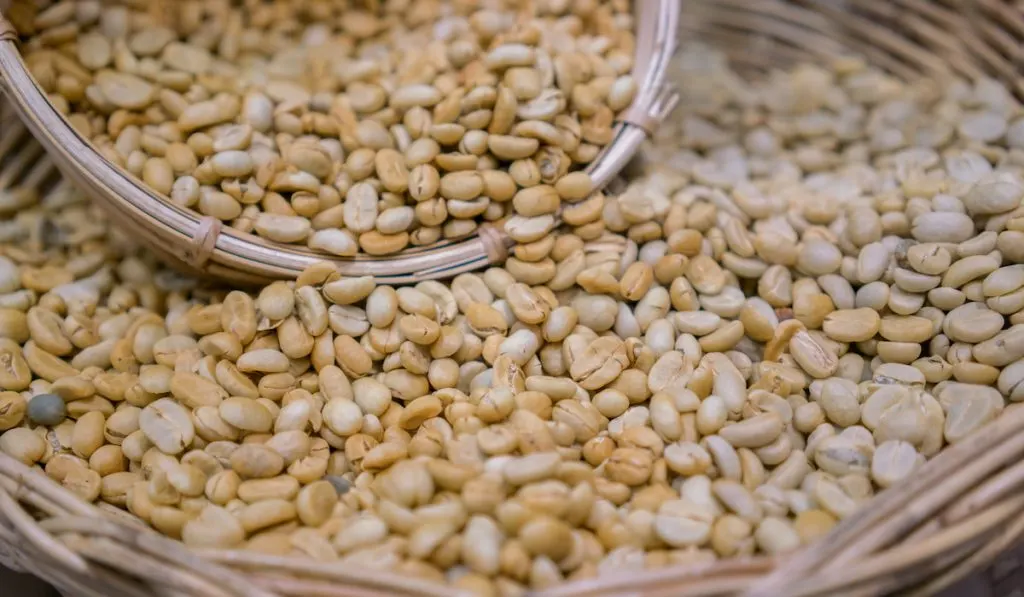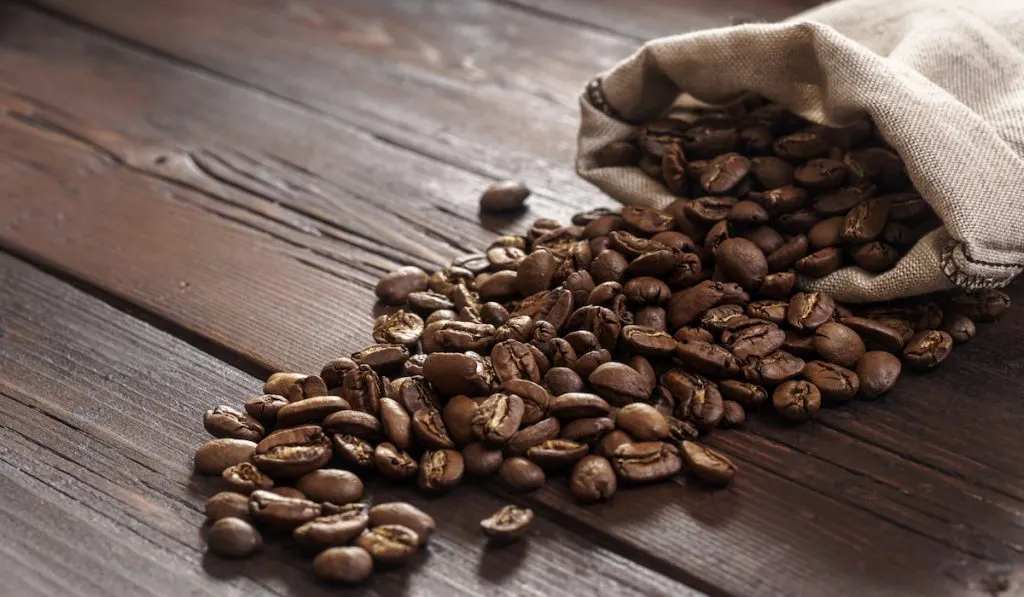Although some people do it, washing green coffee beans before roasting is not a common thing for most coffee enthusiasts.
Is it necessary to wash coffee beans before roasting? How does washing affect green coffee beans?
Read on for a detailed look at this and more.
Should You Wash Green Coffee Beans Before Roasting?
You should not wash green coffee beans before roasting because no matter how you roast them, wet coffee beans result in un-evenly soaked beans.
This in turn leads to uneven roasting on either the core or the outer part of the coffee beans. If this happens, the flavor and taste of the coffee beans are badly affected.
Most people usually wash the coffee beans for fear of bacteria and chaff sticking on the coffee beans. This should not be a thing to worry about when roasting coffee beans because roasting occurs at high temperatures that will kill bacteria and the chaff on the coffee beans will peel off.
How Does Washing Affect Green Coffee Beans?
Coffee beans are hygroscopic, meaning that they are already absorbing moisture from the environment when exposed. Putting them in water, therefore, means that they will absorb more water than is required before roasting, and they will need another cycle of drying before roasting.
Washing leads to the un-uniformly wet coffee seeds that will often get hotter before they caramelize. For this, your coffee beans will not roast uniformly resulting in a burnt bean on the outside while raw on the inside, badly affecting the expected flavor with its grassy-like texture.
Furthermore, green beans are always washed before packaging and are packaged with moisture levels of 10 – 12 percent, the most desired level for beans meant for roasting, making additional washing highly unnecessary.

Why do Some People Wash Coffee Beans Before Roasting?
Most people wash coffee beans before roasting to remove the chaff and mold from the beans. However, before drying and packaging, coffee beans are washed, and the roasting process will kill any bacteria and peel off the chaff.
It is, therefore, unnecessary to wash your beans before roasting.
When pan-stove roasting, some coffee beans roast well with a little moisture, prompting most people to wash them before roasting. Pan-stove roasters roast the beans by conduction since the beans absorb the heat from the metal roaster and roast the bean from the outside to the bean core.
However, this is not the case with coffee air roasters.
Air roasters use convection to roast the beans, meaning that the cores will heat up faster and roast the bean outwards.
If you have a wetter outer seed, the core will get burned before roasting the outer parts of the bean, resulting in a burned coffee bean.
Why You Shouldn’t Wash Coffee Beans Before Roasting
Since coffee beans absorb moisture at a higher rate, washing them results in wet beans, resulting in unevenly roasted beans.
When pan-roasting, moisture allows the outer part of the bean to roast faster than the core through conduction, and for hot air coffee roasters, the core of the coffee beans will roast faster than the outer bean, often resulting in a grassy flavor due to the uneven roasting.
However, washing and drying the beans again before roasting may work but they may lose their natural flavor, and in turn, you will have “dull coffee.”

How to Prepare Coffee Beans for Roasting
Packaged green coffee beans from stores and retailers are always ready for roasting, and they do not need any additional washing.
If you are growing coffee beans and you would like to roast some, preparing them for roasting is a process that starts right from when you harvest them.
Below is a detailed step-by-step procedure.
Harvesting – Coffee cherries are fruits born by coffee plants and are picked when ripe, signified by their color transformation from green to a deep bright red.
Depulping – This is the process of removing coffee beans from coffee cherries, and can be done in three different ways.
First, you can soak the cherries to loosely detach the pulp from the coffee beans, or you could crush or grind the cherries to separate the pulp from the coffee beans.
Lastly, by using your hands, you can squeeze the coffee beans out of the coffee cherries.
However, at industrial levels, coffee processors use machines called de-pulpers to ease the process.
Washing – This rinses off any pulp residues from the coffee beans.
Soaking – After washing, you might need to soak the coffee beans for at least 24 hours to get rid of the slimy texture on the beans. However, if you prefer a more natural and fruity-tasting roasted coffee, this process is not necessary.
Drying – 10–12 percent moisture is conventionally accepted for coffee beans before roasting, making drying them a necessity before roasting, especially after washing and soaking them.
Furthermore, coffee beans with high moisture levels are prone to bacteria and mold formation, making them unsafe for consumption.

What is The Shelf-life of Green Coffee Beans Before Roasting?
Green coffee beans can be safely stored depending on a few factors, including time, moisture levels, and storage temperature.
- Time – You can safely store green coffee beans without losing their important flavor and aroma for 12 months, provided you keep them in a cool, dry, dark, stable, and pest-free environment. Although you can store them longer, your coffee beans might lose their quality and taste.
However, depending on the origin of your coffee beans, you might need to store them for a more limited time. If your coffee beans originate from India, Indonesia, or Central and South America, they will probably be 3-4 months old by the time of purchase.
If they are from Africa, they might be 8-12 months old by the time you purchase. Either way, you should factor in these time frames when storing green coffee beans.
- Moisture Levels – Coffee beans are hygroscopic and are naturally susceptible to changes in humidity. For proper storage, therefore, green coffee beans should be stored in airtight containers or bags, whether at home or in transit, to prevent moisture from ruining the beans.
Although freezing can at times be recommended for long-term storage, thawing coffee beans will flood your coffee beans with water, making them soggy. - Temperature levels – Keeping green coffee beans in a cool and dry place is recommended, most preferably in light-proof bags and away from direct sunlight to avoid drying them out. Environments that are too dry, however, may lead to loss of flavor for the coffee beans.
It is, therefore, best that you store them at room temperature to ensure the freshest possible roasted coffee beans by the time you use them.

What Is The Shelf-Life of Roasted Coffee Beans?
As with most food items, moisture and heat are the biggest enemies to prolonged shelf life. Unlike their green counterparts, however, roasted coffee beans have a shorter shelf life, and you should only roast beans that will be readily used for brewing.
Roasting green beans changes the beans in terms of taste, smell, color, and even size, in turn greatly diminishing their shelf lives.
However, if you need to store your roasted coffee beans to give room for the beans to reach their maximum potential, you can cover the beans in aluminum foil. Although not highly recommendable, this method can extend the roasted beans’ shelf lives for up to 4 weeks.
You can alternatively store your roasted beans in sealed four-layer bags. These bags have a de-gassing valve that allows the roasted coffee beans to “breathe” effectively de-gassing the Carbon (IV) Oxide generated from the roasting process from the beans. This method can effectively store your roasted beans for up to 6 months.

Conclusion
Washing green coffee beans before roasting is not recommended since it leads to bad quality coffee. Washing coffee before roasting often leads to too much water content in the coffee beans, which will not give room for even roasting. Too much moisture negatively impacts the quality of the coffee beans.
Washing should only be considered when pan-roasting because the coffee beans will roast from the outer part into the core. Washing to remove chaff is utterly pointless because the chaff automatically peels off during roasting.
All in all, moisture plays a crucial role in making the best coffee. Green coffee beans for roasting should ideally have 10-12 percent moisture before roasting and you should avoid any conditions that will make your coffee beans gain more moisture, including washing before roasting.
Resources
- https://lostdutchmancoffee.com/Newsletters
- https://coffeecraftcode.com/do-you-wash-green-coffee-beans-before-roasting
- https://roastingtobrewing.com/wash-green-coffee-beans-before-roasting
- https://www.homegrounds.co/how-to-roast-coffee-beans
- https://ictcoffee.com/how-to-properly-store-your-green-coffee-beans-before-roasting
- https://www.coffeebeancorral.com/unroasted-coffee-bean-shelf-life
